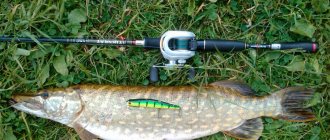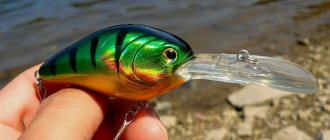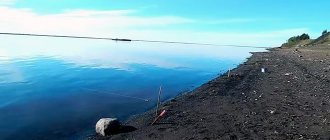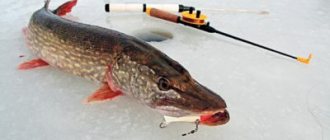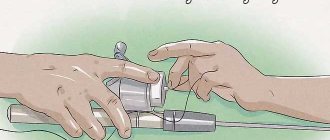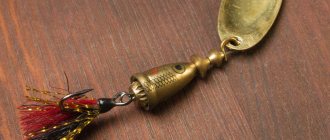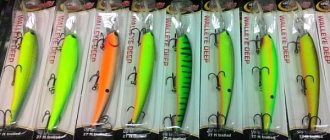Types of wobblers and their markings
Wobbler is a bait made of hard material, which is designed for catching predatory species using a spinning rod. Wood, cork, plastic, and polymers are used in its production. It comes in the form of a small fish, a frog, or a newt. There are forms resembling insects and crustaceans. Depending on the fishing conditions, there are several hundred types of gear.
Fishing with a wobbler
The bait has several parts:
- body – monolithic or consisting of several parts;
- blade - a special element located in the front part of the bait;
- hooks - double type or tees.
The main features, in addition to the external shape, by which one can distinguish the type of wobbler are buoyancy and immersion depth. The size, color and material of each type of bait may be different.
Buoyancy
This feature characterizes the behavior of a wobbler on water. There are different types of bait:
- floating - wobblers that always remain on the surface of the water and do not sink;
- sinking - baits that sink to the bottom under the weight of their own weight;
- neutral (another name is suspenders) - immersed up to 20 cm in water without additional weighting.
An international classification has been developed for each type of buoyancy. Marking of floating wobblers:
- SF – after casting, the bait slowly floats to the surface of the water and remains on it;
- F – the wobbler floats and does not submerge;
- FF – the bait floats up quickly.
For sinking wobblers the following designations are accepted:
- S – bait sinking to the bottom;
- FS – fast sinking;
- SS – the bait slowly sinks to the bottom.
Wobblers with neutral buoyancy are marked:
- SU, SP – the bait is constantly located at a depth of about 20 cm from the surface of the water;
- SSS – the wobbler sinks very slowly from a neutral position to the bottom.
Wobblers also vary in the depth to which they dive.
Immersion depth
There are three types:
- The bait does not sink more than 1 meter. Among these wobblers, the most famous are chaggers and gliders.
- The wobbler can go to a depth of over 10 meters. They are designated DR.
- Gear operating at medium depths - MDR.
For branded bait models, the immersion depth indicator is indicated on the body. Deep-sea wobblers can be distinguished by their massive blade, which has a slight angle of inclination to the base.
Case shape
The shape of the wobbler body can be elongated, spherical, or teardrop-shaped. These varieties allow you to imitate the behavior of the most common prey for predators - fry or small fish:
- Minnow. Thin and elongated body. The shape of the bait resembles a minnow or bleak.
- Crank. The body is flattened from the sides.
- Shed. Shape resembling a small herring.
- Fat. Shortened teardrop-shaped body.
- Popper. A bait that has a recess at the base that imitates the open mouth of a fish. When retrieving, noise and splashes are created, which make the wobbler play similar to the real behavior of the prey of a predatory fish.
- Crowler. This species has two lobes at the base. When retrieving, the bait deviates to the left and right.
Some models have small propellers installed instead of blades. This device may be located at the base or tail of the housing. Sometimes they are made in both parts. These wobblers are called proppers.
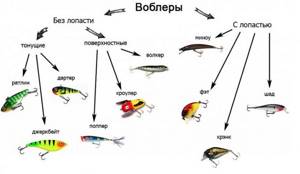
A separate type - baits consisting of several connected parts. Another variety is wobblers that completely imitate the shape of frogs, crustaceans, shrimp, and large aquatic insects.
What kind of fish are wobblers used for?
All types of predators inhabiting the waters of Eurasia are caught with this bait:
- Pike. When catching this predator, large wobblers are used. Various types of massive poppers are effective.
- Perch. Small baits are used to catch it. To improve the result, the wobbler is equipped with shiny elements.
- Zander. Prefers hunting at great depths. The nozzle should have a bright or glow-in-the-dark color.
- Som. To catch large specimens, large wobblers with a splash effect and imitation of the real behavior of the prey are used.
- Trout. Hunts near the surface of the water. An effective bait is in the form of small insects with bright colors.
- Asp. Picks up prey from the water surface. Small and medium sized wobblers are used.
You can fish with a wobbler from the shore or from a boat.
Rules for selecting a wobbler
The bait is selected depending on the fishing conditions and the type of predator. Various wobblers are used in size, shape, and color. The method of conducting the spinning rod is taken into account, attention is paid to the depth of the reservoir, current, and transparency of the water.
Wobblers for trolling
Trolling is a type of fishing when the bait is towed on a rowing or motor boat. This method has another, more familiar name - “fishing on the path”. Trolling correctly with a wobbler is not particularly difficult.
You need to troll, or fish, with a wobbler, which has good mobility with slow retrieval. The most effective with this method of fishing are considered to be lures with a narrow long body and a silver color similar to small scales. Length 6-10 cm.
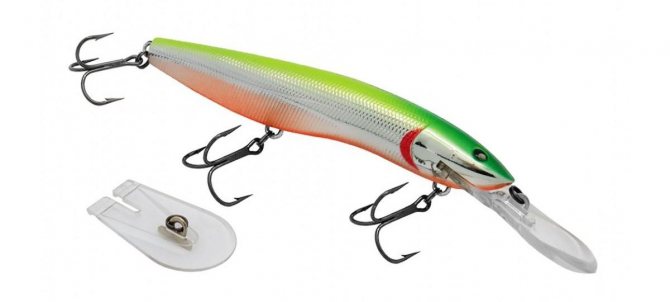
Wobblers for trolling
In summer, in warm weather, wiring is carried out near the surface. Select gear with neutral buoyancy or floating. With the arrival of autumn, when the water in rivers and lakes cools, the fish go to shelters at the bottom. At this time, sinking baits are used.
It is important to choose a wobbler with maximum noise effect and realistic play. The bait should vibrate, play and imitate the behavior of a small fish located at the surface of the water. When trolling, you can deepen the wobbler with a sinker.
Sizing
The size of the bait is selected depending on what type of predator is being fished. For perch and small specimens of pike, small gear sizes are used - 5-7 cm. For larger specimens, wobblers 9-13 cm are selected.
The size of the tackle does not always depend on the type of fish. It often happens that large specimens prefer small baits.
Oscillation frequency
The oscillation frequency of the bait depends on the shape and location of the blade:
- wide blade – increases the amplitude of rotation;
- narrow - the frequency of oscillations of the bait increases;
- small angle of inclination to the base - the wobbler is susceptible to floating;
- The greater the angle, the deeper the bait dives.
Deep models have a long blade with a large angle relative to the body of the tackle.
Degree of buoyancy
If the fish is at the surface of the water, pick up floating wobblers. This type of gear is good for moving past obstacles - vegetation, snags, driftwood. Such models are effective for fishing methods when the bait is floated downstream and then the retrieval begins.
Neutral buoyancy is suitable for jerking retrieves. The bait remains close to the surface of the water, which provokes the predator to attack.
In strong currents, it is better to use a sinking bait. Wobblers with negative buoyancy will help lure predators out of hiding at the bottom of a reservoir.
Your question to an expert
Luka Strelnikov
Professional fisherman with extensive experience
Ask a Question
What are the methods for attaching a wobbler?
Every self-respecting fisherman who is keen on hunting for predatory representatives of water bodies should imagine how to tie a wobbler without subsequently having problems with its loss. You need to have a clear understanding of when, in what way and with what knot, depending on the material of the main cord, you need to fasten it.
There are a number of ways this manipulation occurs:
- The wobbler can be attached to the main cord through a leash with a clasp or by direct connection to the cord.
- The wobbler can be secured using a winding ring.
Attaching the bait through a leash is useful when fishing exclusively for pike. Her teeth do not spare either fishing line or braid. Here a steel leash is a mandatory precaution. As a rule, steel leashes are sold equipped with a swivel on one side and a metal fastener on the other.
To give the bait greater degrees of freedom, and it is no secret that the leash seriously inhibits the play of all wobblers, it is recommended to remove the swivel and make special demands on the fastener.
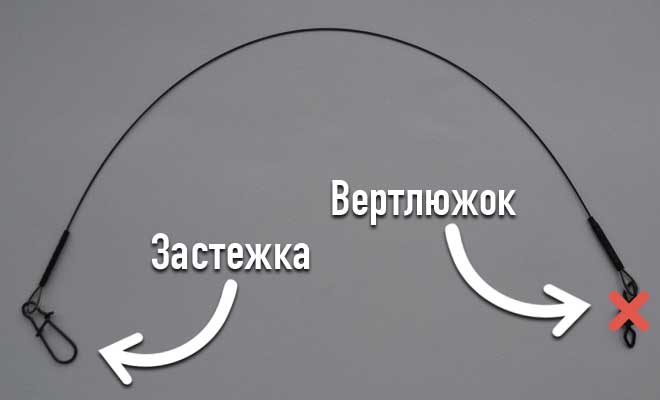
Important! Unlike spoons and especially spinners, wobblers do not twist fishing line or braid. Consequently, the swivel does not provide any useful component in the equipment and can not be used.
The fastener is selected based on the size of the bait. The best option would be a fastener made of strong wire in the form of a hairpin. The fastener is attached directly to the eye, mounted into the body of the wobbler, without any kind of transition elements. The leash itself is tied to the main cord with a blind knot, the types and features of which we will talk about below.
How to properly tie a wobbler directly to the cord, without limiting its movements, can be understood by considering the knots that ensure the formation of a tight loop at the end of the braid or fishing line. Using these features of some nodes, you can tie a wobbler, leaving it all degrees of freedom absolutely without restrictions. As a result of fastening through a tight loop during retrieving, and especially during their pauses, the wobbler for these moments is completely deprived of connection with the rod and cord, showing the maximum of qualities invested in its ability to play by the manufacturer. According to the presented type, baits are knitted for catching fish such as perch, asp, rudd and even pike perch. The absence of a toothy mouth gives confidence in the integrity of the bait and line during the bite.
Important! When the bait is tied directly to a fishing line or braid, its most vivid and expressive game is ensured.
The use of a fastener to attach the bait can be considered only a conditionally direct method of fastening. After all, the fastener during wiring, no matter how miniature it may be, will in any case affect the freedom of operation of the wobblers and limit their capabilities. But many fishermen, omitting this nuance, are happy to use this method of equipment. After all, it is convenient for quickly changing the used artificial fish to another, without wasting time on tying knots and saving the length of the main cord on the edges. If you frequently change bait and retie during one fishing trip, you can lose from one to three meters of the useful length of the cord.
To tie a wobbler, minimizing the restriction of its freedoms and, in addition, avoiding constant tying, you can attach an artificial fish using winding rings. With this method, a winding ring is knitted to the end of the braid or fishing line. The same ring is inserted into the fastening loop of the wobbler; experienced fishermen have probably noticed that some models of wobblers are initially equipped by the manufacturer with this accessory for fastening this type.
The winding ring on the cord is knitted according to the principle of a tight loop. The fish is secured by inserting one ring into another. When the bait is working, the rings do not affect its game, rolling freely over their surfaces, relative to each other, at 360 degrees. The inconvenience is the not very quick change of baits. Although, once you get the hang of it, this manipulation is quite doable within a couple of seconds, and the inconvenience, especially during passive fish activity, pays off with more frequent exits due to the more natural play of the wobbler.
DIY wobbler
You can make the tackle yourself, using a model purchased in a store as a sample. Stages of work:
- Choice of material. Wood or polymers are used. For floating models, it is better to choose lightweight plastic or polyurethane.
- Manufacturing of the body. The future body of the wobbler is marked on the workpiece according to the selected dimensions, then cut out. Two cuts are made - a longitudinal one for the equipment and a transverse one, closer to the base, for the blade.
- Shaping. Use a sharp knife, file, needle file. These tools cut out the body of the tackle. You can use a lathe. Grinding is carried out using an abrasive material. Polish before painting.
- Manufacturing of equipment. Stainless wire is used to make equipment for attaching fishing line and hooks. Depending on the model, there may be two or three tees.
- Making the blade. The blade is made from fiberglass up to 2 mm wide. Its shape and size may be different.
- Installation of elements. Using glue or epoxy resin, the blade and equipment are strengthened on the body. All gluing areas are sanded.
- Coloring. After polishing, paint is applied. You can insert foil and plastic elements glued to the base. The body is varnished.
During the manufacturing process, additional lead weights can be added to the body. Video on how to make a wobbler with your own hands at home:
How to properly catch pike with a wobbler
The activity of the predator typically differs depending on the season. This is due to climate change. In autumn, when the water temperature drops lower, pike begin to gain weight in anticipation of cold weather. The pre-spawning and post-spawning periods also affect the bite. Taking these details into account, the angler adapts to the activity of the fish and tries to select the optimal bait.
Advantages of wobblers:
- high frequency game;
- abundance of postings;
- high percentage of bites sold;
- wear resistance and density of the material;
- additional noise effect (for models with a built-in capsule).
If stored carefully, one bait will yield a catch for many years, which is an absolute advantage.
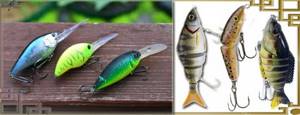
Spring Summer
The melting of the last ice saturates the stagnant water with oxygen and slightly activates the bite of underwater inhabitants. At this time, composite models of light colors are effective. Wiring is done slowly, with slight tweaking and stopping for a few seconds. When the water warms up to 10-12 degrees and becomes transparent, small “cranks” and “fats” of natural colors are used.
During the pre-spawning period, large-sized baits are popular, but this period does not last long - a few weeks. After spawning, the predator gets sick and practically does not feed. At this time, individuals of 200-500 g are caught on the hook.
To learn more:
How to make your own chatterbox for fishing
In the summer heat, pike sit out in deep-sea ambushes and come out to feed in the morning and evening hours. The best summer bait in the current is a minnow wobbler, since it imitates the usual “toothy” bleak. The lake predator prefers wide baits, as well as surface poppers.
Autumn and early winter season
With the first cold weather, the spotted beauty begins to actively feed throughout the daylight hours. Closer to mid-autumn (September, October), when underwater vegetation settles, wobblers with shallow depth work effectively in shallow water. In those places where it was impossible to conduct wiring in the summer, one should expect the predator to come out. With frosts, the biological rhythms of pike slow down, and instinct forces them to slide into wintering pits. It is not easy to catch a predator in late autumn, in November, or during freezing conditions. For this purpose, deep-sea “rattlins” and “cranks” of natural colors are used. In such conditions, suspenders bring results.
Fishing from ice is possible only with rattlins, which are to the taste of the toothy hunter.
Fishing with a wobbler
The technique of casting this bait differs from trolling. With the help of special wiring, you can achieve similarity in the behavior of a small fish, which serves as a good bait for predators. Beginners need training to fish correctly with a wobbler.
Casting bait
It is necessary to accurately deliver the bait to the places where the fish are expected to be located. To do this, the fishing line on a spinning reel is wound so that the distance from the leash to the tip of the rod does not exceed 20-30 cm. The bracket is moved back, the fishing line is pressed on the crook of the index finger.
The rod is pulled back and with a sharp flick of the wrist the bait is sent to the fishing spot. If the tackle is diving, it is given time to sink. The reel handle is used to wind the line. At the same time, a wobbler plays, imitating the behavior of prey for a predator.
Fishing from the shore
It is better to fish with a wobbler from the shore using a floating or neutral bait. This will prevent snags on bottom vegetation and driftwood. This type of gear will also help to avoid surface obstacles when guiding. Choose the longest possible rod for long casts.
From the boat
If you fish with a wobbler from a boat, you can use sinking and surface bait. For convenience in limited space, choose a rod up to 2 meters long. You don’t have to make long casts and send the bait 10-15 meters to the fishing spot.
Twitching
This is a method of spinning fishing with a wobbler. It consists in the fact that during wiring, wrist jerks of varying degrees of intensity are made. The bait begins to actively play and provoke the predator to attack. Constant hand movements can lead to fatigue; for this, select a light rod up to 1.5 meters long.
For beginners who are not familiar with this method, you can watch a video on twitching for beginners to learn how to fish with wobblers:
Summer and winter fishing
In summer, the tactics of fishing with a wobbler do not differ much from traditional lure methods. Any type of bait can be used. The predator actively hunts in the warm season and is located in the upper and middle layers of the reservoir. Floating and neutral baits are used.
In winter, the fish are inactive and are in a sleepy state near the bottom. The space for fishing is limited by a hole drilled in the ice. Short fishing rods with a sinking wobbler are used. The bait sinks to the bottom, with vertical jerks it is forced to play and provoke the predator to bite.
How to choose a wobbler for pike fishing
A fisherman's box should have bait for all occasions. There is no universal nozzle that works in all conditions, so you will have to adjust it directly on the shore of a lake or river. The choice of wobbler depends on the reservoir, the depth of a particular area, underwater vegetation and obstacles, currents, and weather.
To learn more:
Features of catching pike on girders
Size
Pike has an impressive mouth with many teeth, so small wobblers are not always used. The size is also affected by seasonality: in cold water, experienced fishermen recommend using smaller models than in the warm season. Individuals up to a kilogram are caught on bait of any size. Sometimes the “toothy” one attacks 2-inch perch silicone.
When going after a trophy specimen, arm yourself with wobblers measuring 120-130 mm, since a seasoned pike will not waste energy chasing “trifles.” A predator of 3 kg or more often lives on the edges of the riverbed rather than in the thickets of shallow water.
Colors
The choice of bait color depends on weather conditions, seasonality, water transparency, and fishing location. On a clear day, the dark and natural spectrum works better: “olive”, “machine oil” or “ultraviolet”. Cloudy weather similarly changes the color scheme in the opposite direction. Light ones perform better when the sky is overcast. A similar situation arises with other conditions.
Transparent water is optimal for natural colors, and cloudy water is optimal for light and acidic shades. When choosing bait, adapt to specific fishing areas. Each body of water is unique, so experiment often.
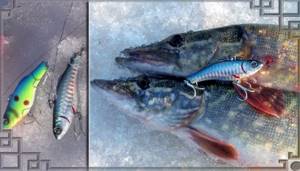
Form
The structure of the predator’s strong jaws allows it to feed not only on fish, but also on frogs, waterfowl rodents, and birds. Unlike pike perch, which can handle elongated minnows, pike readily responds to cranks, shads, fats, and imitations of wide-bodied fish. In addition to classic models with a blade, the market offers baits without it - rattlins, poppers. The former work in the lower water horizons (bottom layer), while the latter work exclusively on the surface.
